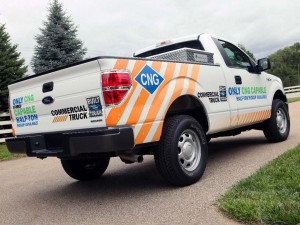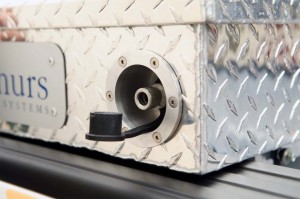While the U.S. is literally flowing with new sources of relatively clean and cheap natural gas, the fuel has largely been ignored by the auto industry – but that could soon change as Ford Motor Co. and other manufacturers become increasingly fired up about CNG.
Until now, Ford had relied on aftermarket convertors to service the relatively few customers who have wanted to run their vehicles on compressed natural gas. But the automaker will offer a CNG option on its half-ton, or light-duty, pickup later this year.
Buyers will be able to order the F-150 truck with either a natural gas or LPG option. The options won’t come cheap, with the total costs running as high as about $10,000. But for fleet customers who clock significant mileage each year, the savings should quickly add up since CNG costs barely half as much as regular-grade gasoline.
“Businesses and fleet customers have been asking Ford to make F-150 available with CNG capability to take advantage of the fuel’s low price and clean emissions,” explained Jon Coleman, Ford fleet sustainability and technology manager. “With the money saved using CNG, customers could start to see payback on their investment in as little as 24 to 36 months.”
Owners aren’t the only ones who could benefit from the increased use of CNG. According to the Environmental Protection Agency, the fuel produces about 30% lower greenhouse gas emissions than regular unleaded gasoline on a per-mile basis.
Then why hasn’t CNG been gaining more traction, especially as the nation’s fracking boom creates a veritable glut of the gaseous fuel? There are a number of potential problems:
- For one thing, there are relatively few places where a motorist can re-fuel. Most CNG stations are operated by private fleets that have already taken advantage of the reduced operating costs;
- CNG tanks are large and round and take up a lot of space in a trunk or cargo bed where plastic fuel tanks can be tucked into various nooks that don’t rob storage or passenger space;
- The tanks and other necessary equipment modifications don’t come cheap.
Indeed, Ford says the new option package it will begin offering for 2014 will cost $315 as the maker upgrades the fuel line, switches to modified valves, pistons and rings that can tolerate the drier fuel. The final modifications will still be done by select Ford Qualified Vehicle Modifiers, and could add another $7,500 to $9,500 to the price tag.
But the payback could come quickly considering CNG currently goes for around $2 for the equivalent of a gallon while gasoline has been pressing up as high as $4 a gallon in the U.S. in recent months, according to the AAA. The precise savings will vary depending on both the final installation cost and the number of miles an owner logs – the more the vehicle is driven the faster the payback.
The Ford CNG/LPG package will be offered specifically for use with the maker’s 3.7-liter V-6 engine. Along with the new F-Series package, Ford already has CNG/LPG prep kits available for various commercial truck models, the Transit and Transit Connect vans, F-Series Super Duty pickups and E-Series vans.
Like those other packages, the new F-Series prep kit will allow a driver to run on cheaper CNG or switch to regular gasoline if the alternative fuel isn’t available.
Ford isn’t entirely alone in offering a bi-fuel truck capable of running on alternative fuels like natural gas. Chrysler and General Motors have their own packages. And a number of aftermarket “up-fitters” will convert just about any vehicle to use CNG for a price. The gas has become popular with taxi and bus fleets around the country, for example.
Even so, only an estimated 125,000 of the 250,000 million vehicles now on the road in the U.S. can use CNG, according to the Department of Energy. Ford hopes to add another 15,000 this year alone.
Late last year, a coalition of 22 states came together to advise automakers they would create a market of as much as 5,000 to 10,000 CNG-fueled vehicles annually, something Colorado Gov. John Hickenlooper said he believed “should be enough to get them to move.”
“Right now as a transition fuel, it’s way ahead of those other choices,” said Gov. Hickenlooper, referring to battery power and hydrogen fuel cells. “It’s less expensive, it’s cleaner.”



My father-in-law had a Chevrolet Aveo (called Sonic in the US) that saved me a lot of money taking friends on a weeks’ trip around Sicily. GPL, as CNG is called in Italy, costs exactly half of benzina (gasoline). Its offered on numerous models there, especially on the cheaper cars where the $1500 premium for the ubiquitous clean diesel engines can’t be justified.
Roush has been doing a lot of HD truck CNG conversions over the years. Propane and CNG have become common in Germany. Unfortunately there are a couple issues with CNG/propane for automotive use that need to be addressed.
The first is that an engine needs to be properly designed and built with the correct materials to use “dry” combustible fuels such as CNG/propane. Gas and Diesel fuels have a natural lubricity along with additives that prevent excessive wear of valves, guides, piston rings, etc. that occurs with “dry” fuels like CNG/propane. Without the proper design and materials, a normal engine converted to CNG/propane wears out rapidly.
The second issue is mileage or distance traveled per tank of fuel. CNG/propane for use in engines needs to be in relatively high volume to the point of liquid form om entry in to the engine. This means the storage tank(s) in a vehicle must be large in capacity and physical size. These storage tanks must also be able to withstand very high pressures as CNG/propane in liquid form needs to be under high pressure. Thus the actual distance a vehicle can travel with CNG/propane can be very limited in comparison to gas or Diesel fuel powered vehicles.
Finally there is the safety issues with CNG/propane. Because these fuels must be under very high pressure to be stored in liquid form and like all gases they expand with heat, there is a substantially greater risk of an explosion if there is any leak or in the event of an accident. That is bad enough by itself but when refilling these vehicles the pressure must be even higher. To prevent over-filling which is dangerous, there is a safety blow-off valve.
I have personally been witness to what happens when these blow-off valves pop open when refilling a car in Germany. There is a sonic boom that is just short of glass shattering and I’m not exaggerating. In addition the discharge of CNG/propane that occurs when this valve opens literally fills the air for a radius of 30 or more feet and the vapor is in an extremely explosive state. A hot exhaust manifold, a person smoking a cigarette 50 feet away or any other hot object such as a street light, etc. can cause an explosion of this concentrated gas vapor that escapes. It’s a very scary situation not to be taken lightly.